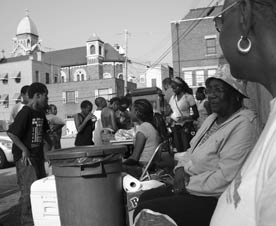In 1984, Neil Wollman wrote a letter to the Teachers Insurance and Annuity Association-College Retirement Equities Fund (TIAA-CREF), innocently beginning a long campaign that proves how the persistent efforts of one person can change large institutions. Wollman, then a psychology professor at Manchester College, a small school in north central Indiana, invested money in TIAA-CREF for his retirement. In his letter, he asked the fund to divest from companies that did business in South Africa or built nuclear weapons.
TIAA-CREF, one of the nation’s largest retirement investment groups, was unlike many other pension and investment firms that care only about short-range financial returns. It has had a long history of shareholder activism, especially for reform of corporate governance. But there were limits to TIAA-CREF’s social engagement, and many corporations in which it invested profited from oppressive and socially unacceptable practices.
Wollman was an unusual candidate to play the role of social activist. As a political-science student at Northwestern University during the Vietnam War, he was a passive observer of campus anti-war activities. He was ideologically sympathetic to libertarian novelist and philosopher Ayn Rand and espoused a philosophy of the “radical right” — almost anarchism. But shortly after arriving at Manchester, he encountered Ken Brown, a professor in the school’s peace studies program. The two engaged in lively conversations that led to a change in Wollman’s outlook on the world.
Political movements against South African apartheid and nuclear weapons in the early 1980s also influenced Wollman. Not wanting his retirement investments to support corporations whose operations conflicted with his values, he asked TIAA-CREF to establish an alternative investment fund. In response, he got a form letter stating that the financial-services company could not divest as Wollman had requested. The letter did not address his proposal for a socially conscious alternative fund.
Wollman began organizing to pressure TIAA-CREF to change. Under the organizational name of “Clean Up TIAA-CREF” (sometimes shortened to “Clean Up CREF”), Wollman recruited two other academics — his mentor and friend Ken Brown and Donald Pelz of the University of Michigan.
“We just got other people interested through brochures, conferences, little pieces in activist newsletters, and word of mouth,” Wollman says. “It was always part-time and extracurricular. People were always surprised at the influence there was on such a big group as TIAA-CREF from an organization working on the margins.”
Clean Up TIAA-CREF asked people to write letters in support of a socially conscious alternative investment fund. It organized a small contingent of protestors to picket and give speeches at TIAA-CREF annual meetings. Supporters pushed their demand for an alternative fund and received publicity in prominent publications, including The New York Times and Business Week.
TIAA-CREF officials “actively fought [against the alternative fund] for a number of years and gave reasons why they couldn’t do it financially or legally,” Wollman says. “Whether they investigated it or not, I don’t know.” But the letters and protests had their effect, especially since a broader social movement on behalf of socially conscious investing was growing. Some retirement funds were demonstrating that investing could be both profitable and guided by social or ethical concerns.
In 1990, TIAA-CREF agreed to launch a Social Choice Account, which has now grown to about $9 billion in a mixture of stocks and fixed-income investments (out of a total of more than $400 billion in all of TIAA-CREF’s 40 funds). “The Social Choice Account came about because of participant demand,” says Amy O’Brien, a director of social and community investment at the fund. “Higher education folks really care about their values alongside their investment strategies.” O’Brien says. “For many years we’ve been in dialogue with them.” Now about 430,000 out of 3.2 million TIAA-CREF participants, especially younger investors and highly educated women, put some investment in the Social Choice Account.
Wollman disbanded Clean Up TIAA-CREF after the Social Choice Account was established but continued informal dialogue with TIAA-CREF officials. He later restarted campaigning under a new name, Social Choice for Social Change. His new goal was to pressure TIAA-CREF to go beyond the “negative screens” on investment that are designed to exclude companies that do bad things, like sell tobacco, and adopt “positive screens” to seek out companies that do social and environmental good. He also pushed for community investing — investments targeting needy communities that typically lack access to capital.
Experts often divide socially responsible investing into three categories: social screening of investments, shareholder activism, and community investing. While negative screening makes investors feel better about where their money is used, shareholder activism and community investing can have more noticeable influence by changing corporate policies or directly supporting positive investments, such as affordable housing or renewable energy.






Comments